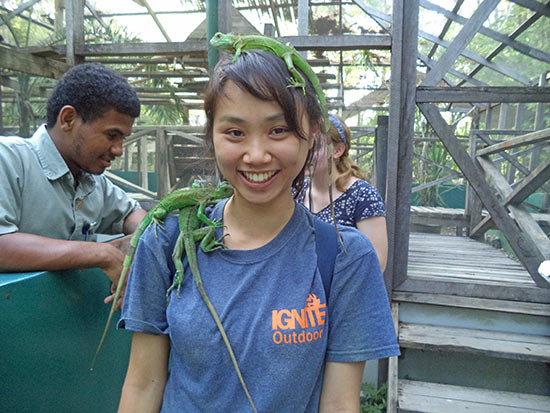Maggie Lau: Student Report from 2015 Alternative Summer Break in Belize

Overview
We worked at Barzakh Falah, a developing community which aims to provide a home for girls who aged out of the orphanage system. During this trip, we stayed with the founders of this community, Nancy and Jamie Marin. The main idea of the project is to build a house for these girls using sustainable earth bags. What makes this project interesting is that the entire house is constructed from recycled materials, such as old car tires and empty feedbags. Since earth bags are stacked on top of each other, the entire house is built with compression only.
The Project
After a two and a half-hour plane ride to Belize City and a two-hour bumpy ride to San Ignacio, we arrived at our guesthouse and were greeted by our host family and their overly active dog. Every morning, we would wake up to a hearty breakfast, which includes fresh fruit juice and either a Belizean (e.g. pumpkin porridge) or American meal, after which we would head off to the work site.
There were four completed earth bag houses at the work site, and we worked on the fifth and largest house. This house has three levels, including an underground root cellar. Since we were the first group working on this house, we focused mainly on building a strong base. When I first saw the pile of old tires in a nine-feet deep by fourteen-feet wide hole, I realized the house we are helping to build is a lot bigger than what I had expected.
On the first day, we arranged the car tires along the circumference of the house. The tires prevent water from entering the root cellar. We spent hours gathering old car tires from what seemed like a mile away, shoveling soil and rocks into the tires, and packing the tires until they are sturdy.
Over the next few days, we lined the house with earth bags. Some of us shoveled dirt into the hole while others worked on mixing the earth bag mixture (which consists of one part limestone, ten parts sand, and lots of water), and filling the earth bags. Throughout the week, Jamie and his assistant came up with ingenious ideas such as building a compass to align the earth bags, as well as a chute to ease the process of transporting soil into the hole.
Fun Times
On most days after work, we would embark on fun adventures. For example, we visited the Green Iguana Conservation Project in the San Ignacio hotel, where green iguanas (mostly females) were protected from hunters. We learned several fun facts about iguanas (e.g. iguanas have three eyes!!), and had iguanas crawling all over us. At one point in time, I had four baby iguanas crawling all over me! On another trip, we rode horses along the Mopan river to the Xunantunich, an ancient Maya archaeological site.
Other activities we did include canoeing along the Macal River, hiking to a swimming hole (where our tour guide, Felix, showed us a small hidden limestone cave), visiting the market (where we practiced our bargaining skills and managed to get great deals on souvenirs), and going to the Belize zoo.
Thoughts
This has been an eye opening and enriching experience. Our host family—Nancy and Jamie Marin—are very friendly and showed a lot of passion for their project. Jamie worked with us under the scorching sun, and even his son Leo came and helped us with shoveling the sand. Nancy is very inspirational; Barzakh Falah is her dream. She has a vision of providing abandoned children with a home, a place where they can be nurtured rather than live on the streets and join gangs. Although this is one of the most labor-intensive volunteer work I’ve ever done, I’ve learned a lot from it, such as the earth bag method to build houses. I also enjoyed the friendly, relaxed environment in Belize, and learned more about their culture (e.g. Belizean cuisine).